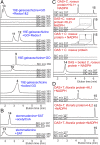Solution of the multistep pathway for assembly of corynanthean, strychnos, iboga, and aspidosperma monoterpenoid indole alkaloids from 19 E-geissoschizine
- PMID: 29511102
- PMCID: PMC5866588
- DOI: 10.1073/pnas.1719979115
Solution of the multistep pathway for assembly of corynanthean, strychnos, iboga, and aspidosperma monoterpenoid indole alkaloids from 19 E-geissoschizine
Abstract
Monoterpenoid indole alkaloids (MIAs) possess a diversity of alkaloid skeletons whose biosynthesis is poorly understood. A bioinformatic search of candidate genes, combined with their virus-induced gene silencing, targeted MIA profiling and in vitro/in vivo pathway reconstitution identified and functionally characterized six genes as well as a seventh enzyme reaction required for the conversion of 19E-geissoschizine to tabersonine and catharanthine. The involvement of pathway intermediates in the formation of four MIA skeletons is described, and the role of stemmadenine-O-acetylation in providing necessary reactive substrates for the formation of iboga and aspidosperma MIAs is described. The results enable the assembly of complex dimeric MIAs used in cancer chemotherapy and open the way to production of many other biologically active MIAs that are not easily available from nature.
Keywords: Catharanthus roseus monoterpeoind indole alkaloids; catharanthine assembly; multiple-pathway gene function; tabersonine assembly; virus-induced gene silencing.
Copyright © 2018 the Author(s). Published by PNAS.
Conflict of interest statement
Conflict of interest statement: V.D.L. and Y.Q. have filed a patent (PCT/CA2017/050284).
Figures



References
-
- De Luca V, Salim V, Atsumi SM, Yu F. Mining the biodiversity of plants: a revolution in the making. Science. 2012;336:1658–1661. - PubMed
-
- Le Men L, Taylor WI. A uniform numbering system for indole alkaloids. Experientia. 1965;21:508–510. - PubMed
-
- Tarselli MA, et al. Synthesis of conolidine, a potent non-opioid analgesic for tonic and persistent pain. Nat Chem. 2011;3:449–453. - PubMed
-
- Salim V, Wiens B, Masada-Atsumi S, Yu F, De Luca V. 7-deoxyloganetic acid synthase catalyzes a key 3 step oxidation to form 7-deoxyloganetic acid in Catharanthus roseus iridoid biosynthesis. Phytochemistry. 2014;101:23–31. - PubMed
Publication types
MeSH terms
Substances
Associated data
- Actions
- Actions
- Actions
- Actions
- Actions
- Actions
- Actions
- Actions
- Actions
LinkOut - more resources
Full Text Sources
Other Literature Sources
Molecular Biology Databases

